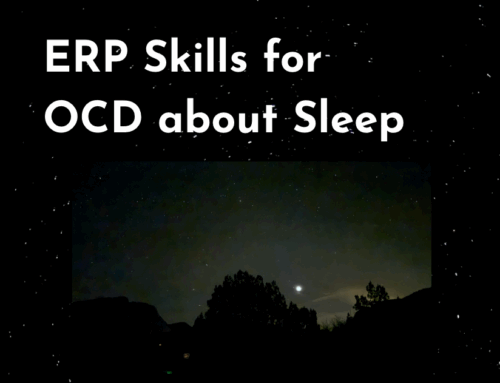 ✅ Key Takeaways
✅ Key Takeaways
- OCD mental rituals are just as important to target in ERP for OCD as physical compulsions
- Exposure scripting helps you embrace uncertainty and interrupt mental compulsions
- MOMNs and Shoulders Back! are mindfulness-based ERP tools
- Choosing not to mentally ritualize can be a powerful—and liberating—form of exposure
- Links in the text below will take you to more detailed information about the concepts presented
⏱️ Estimated Reading Time: 6–7 minutes
How mental compulsions can start
One of the earliest—and most rigid—rules my OCD taught me was something I called Rule #1:
You cannot get caught doing these things or thinking these thoughts.
Because if you do, you will have to explain yourself.
And you don’t tell what you see in your mind.
Because if you do, all those bad things you see … you will make them happen.Is Fred in the Refrigerator? Taming OCD and Reclaiming My Life p. 29
To survive in a world dominated by OCD’s Rule #1, I learned to shift my compulsions from physical behaviors that people could catch me doing to ones no one could see—mental rituals. That meant I became very good at mentally checking, analyzing, arguing, and trying to “figure it out” in my head. From childhood onward, mental compulsions became the way I pacified the monster that was my mind, although the more I used them, the more I seemed stuck in a hellish mental prison.
Mental rituals can sabotage ERP for OCD
When I started doing Exposure and Response Prevention (ERP) for OCD, I saw some progress—but not nearly what I hoped for. I was diligently doing exposure exercises, but I was still secretly responding with mental rituals. The result was partial response prevention, which meant I wasn’t fully breaking the OCD cycle.
I then learned a way to interrupt the hellish cycle of mental compulsions I was stuck in from reading Dr. Jonathan Grayson’s Freedom from Obsessive-Compulsive Disorder. In his book, he shared exposure scripts that were direct hits to OCD’s real fear: uncertainty. As I share in my memoir, I finally realized:
“My fears weren’t about bad things happening. They were about not knowing whether bad things were going to happen. … To keep myself from doing mental rituals, I need to talk back to my OCD, telling it that whatever it’s threatening may or may not happen, and embracing the general uncertainty of the situation…” p. 183
A new take on mindfulness for mental compulsions: “may or may nots”
This led me to the practice of exposure scripting, or what I refer to as may or may nots (MOMNs). The idea is to interrupt mental compulsions by leaning directly into uncertainty, such as “[whatever OCD is worried about] may or may not happen.”
Saying MOMNs out loud can function well as both proactive and reactive ERP tools. They are designed to:
- Make it much more challenging to do mental rituals
- Increase anxiety (on purpose!)
Turning “what if?” into “may or may not” helps you stay present with obsessions without doing mental rituals. In other words, MOMNs help you to mindfully be in the presence of these thoughts without compulsively interacting with them. As Jon Hershfield and I say in Everyday Mindfulness for OCD, “ERP is essentially a meditation on a trigger” (p. 65).
Shoulders Back, the most powerful form of mindful ERP
After getting skilled at recognizing mental compulsions and interrupting them with MOMNs, I then developed a practice I call Shoulders Back. It’s a posture, a mindset, and a mindfulness/ERP skill all in one. With Shoulders Back, when OCD is triggered, I act as though the content of my obsession is irrelevant, a skill I learned from Dr. Reid Wilson (who wrote the Afterword to Fred) that is the essence of good exposure therapy. As part of acting as though OCD’s worries are irrelevant, I then turn my attention back to what I care about without addressing OCD at all.
If you were doing mindfulness meditation, you would be focusing on something like your breath, and when your attention got carried away by a thought (as would happen repeatedly), you would recognize it and come back to your breath. When you’re focused on something you care about and your attention shifts because of an obsession, the same process applies when you use Shoulders Back. You recognize the distraction and bring your attention back to what you were doing. In other words, Shoulders Back is also mindfulness.
What I learned is the less I interacted with OCD in my head, the fewer intrusive thoughts I had. By treating the obsessions as irrelevant, my brain learned “nothing to see here” whenever they came up. If I’m not going to treat the intrusive thoughts as important, then neither is my brain, i.e. it’s going to stop bringing them up so frequently. This is what makes Shoulders Back so powerful.
How do you know whether using MOMNs or Shoulders Back would be most helpful?
- When anxiety is high and OCD feels overwhelming, I often find MOMNs to be helpful.
- When you’re able to ignore OCD and refocus, then I rely on Shoulders Back.
“Can you ignore OCD’s invitations and focus on what you’re doing? Yes: Shoulders Back. No: MOMNs.” Both are helping you do ERP with full response prevention. And both are mindfulness.
Learning to live with uncertainty without mental rituals
Two of the biggest takeaways from my journey to reclaim my life from OCD and mental rituals are:
- Talking to OCD in my head doesn’t ever fix the issue OCD is worried about!
As I was working on reducing mental rituals sometimes I would ask myself, “What in the world am I doing in my head? What do I think this is accomplishing?” It’s doing nothing other than making me miserable and making OCD stronger. That’s not a trade-off I’m willing to make anymore. - Not doing mental rituals is a form of exposure.
When you resist, OCD will threaten worse consequences. It will scream louder. But the less I engage, the more freedom I gain.
Freedom from mental rituals is possible!
What’s ironic is that what seemed like the hardest truth in the beginning of my recovery has turned into the greatest gift, as I share in Fred :
As I digested this key understanding [that embracing uncertainty was the key to taming OCD], I felt simultaneously anxious and liberated. Anxious because it dawned on me that almost everything in life was uncertain and I didn’t have much control over anything. Liberated for the very same reason.” P. 183
Trying to control everything is exhausting and what’s more: it doesn’t work anyway! Mental freedom comes from being able to recognize that so much of life is out of our control, so we can let go and stop trying to control it all. We can learn to live with all this uncertainty and be happy anyway.
Learn more about taming OCD
To learn more about how I used the ERP tools above as part of my OCD-taming strategy, see Is Fred in the Refrigerator? Taming OCD and Reclaiming My Life. Click here to purchase your copy.
Sign up for my Shoulders Back! newsletter to receive OCD-taming tips & resources, including notifications of new FredTalks, delivered every month to your inbox.
My blogs are not a replacement for therapy, and I encourage all readers who have obsessive compulsive disorder to find a competent ERP therapist. See the IOCDF treatment provider database for a provider near you. And never give up hope, because you can tame OCD and reclaim your life!







Like how MoMNs ties to mindfulness. Very helpful. Will put in practice.